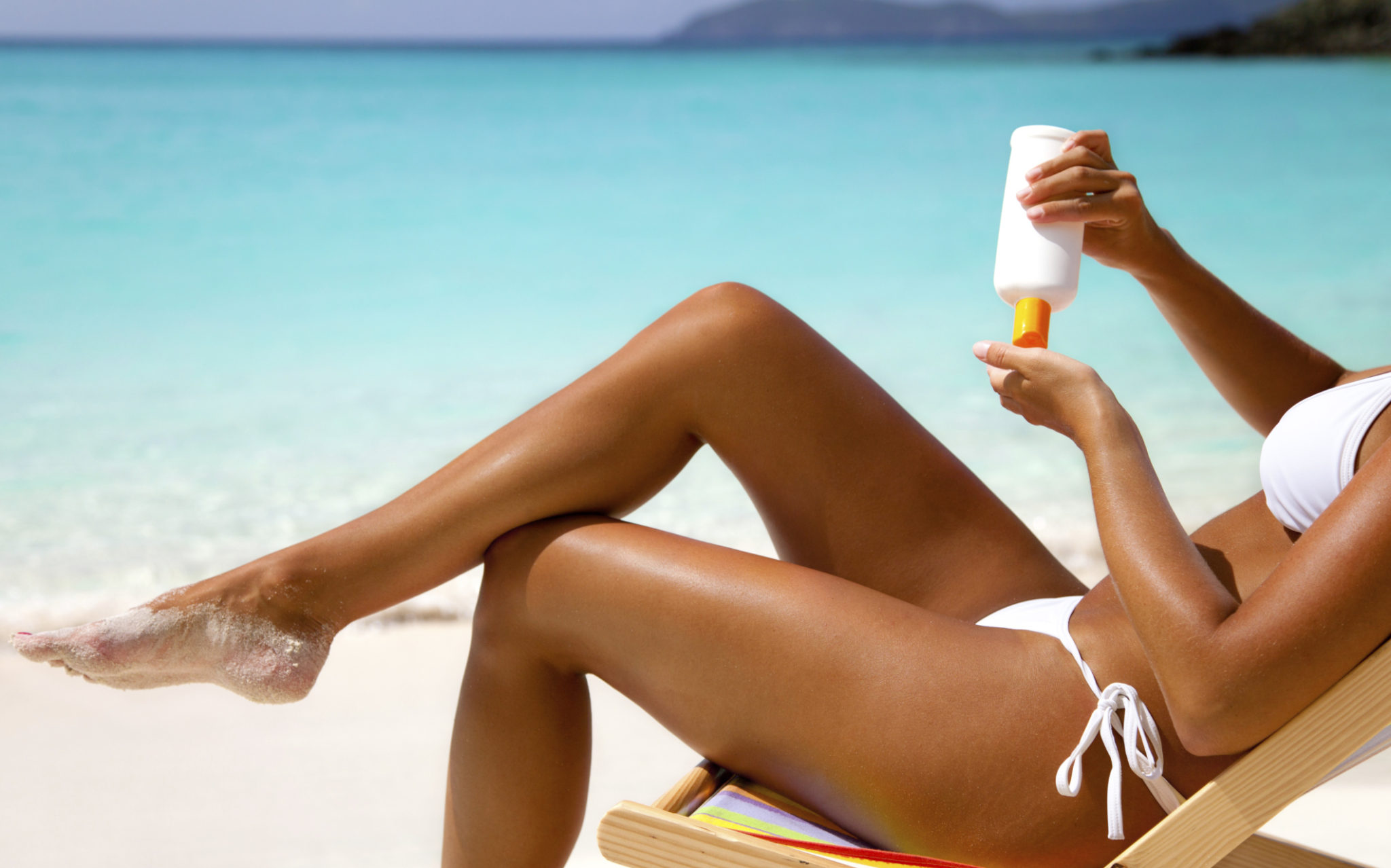Sun Tanning – But First, Some Sun History
 It was over 400 years ago that Copernicus declared that the sun was the center of our universe. Throughout history, the human race has had a special relationship with the sun. Primitive societies in every continent have worshiped the sun as the god that provided warmth and made the crops grow.
It was over 400 years ago that Copernicus declared that the sun was the center of our universe. Throughout history, the human race has had a special relationship with the sun. Primitive societies in every continent have worshiped the sun as the god that provided warmth and made the crops grow.
Cultures changed over hundreds of years and class systems developed and the sun became a symbol of a different kind, one that clearly defined who you were. Skin color became that visible definer – one that separated working classes from the ruling classes, and separated the master from his servants. Pale skin belonged to the leisure upper classes, while darker skin indicated a life of outdoor labor. The paler one’s skin the higher the class, and men and women went to great (and sometimes unhealthy) lengths to be pale.
Women of ancient Greece and Rome used lead paints and chalks to whiten their faces. Unfortunately this beauty treatment could cause death through slow lead poisoning.
 By the mid-10th century, arsenic became the preferred skin whitener, once again with sometimes deadly results. Other methods of making the skin white were less poisonous — during the reign of Queen Elizabeth, women painted thin blue lines of their foreheads to give their skin a translucent look, and carried parasols or wore masks whenever they ventured outdoors.
By the mid-10th century, arsenic became the preferred skin whitener, once again with sometimes deadly results. Other methods of making the skin white were less poisonous — during the reign of Queen Elizabeth, women painted thin blue lines of their foreheads to give their skin a translucent look, and carried parasols or wore masks whenever they ventured outdoors.
These class distinctions found their way to America, where no Southern belle or Northern society debutante dare go out in the sun without her parasol to protect her delicate pallor. It wasn’t until the 20th century that society began accepting bronzed skin.
Blame It On The French
 Two French celebrities can be credited (or blamed) with the transformation from pale to tan. In the 1920s, as fashions were freeing women from confining clothes, thanks in part to designer Coco Chanel, she inadvertently gave the fashion world another new trend: while cruising from Paris to Cannes, she obtained a suntan, probably by accident.
Two French celebrities can be credited (or blamed) with the transformation from pale to tan. In the 1920s, as fashions were freeing women from confining clothes, thanks in part to designer Coco Chanel, she inadvertently gave the fashion world another new trend: while cruising from Paris to Cannes, she obtained a suntan, probably by accident.
At the same time fashions were changing, so were lifestyles. Women came out of the house to enjoy outdoor life, with hiking, picnics, lawn tennis and other “acceptable” yet still “feminine” activities. Soon, fashionable women everywhere threw away years of tradition to be tanned.
 On beaches throughout Europe, women sunbathed, wearing decorative sun hats and shawls not for protection but as fashion statements. Brown and beige-tinted powders and creams were created to be brushed on the places the sun had missed. The fashion world featured clothes for women who wanted to flaunt their new tans; shoes were worn without stockings and sleeveless dresses became stylish. Bathing costumes that had covered women’s legs with bloomers, now bared the leg, and swimming became an acceptable sport for women. The suntan had arrived…as the symbol of wealth and leisure. A tan in the winter meant the bearer had enough money and status to afford a vacation to an exotic, warm climate.
On beaches throughout Europe, women sunbathed, wearing decorative sun hats and shawls not for protection but as fashion statements. Brown and beige-tinted powders and creams were created to be brushed on the places the sun had missed. The fashion world featured clothes for women who wanted to flaunt their new tans; shoes were worn without stockings and sleeveless dresses became stylish. Bathing costumes that had covered women’s legs with bloomers, now bared the leg, and swimming became an acceptable sport for women. The suntan had arrived…as the symbol of wealth and leisure. A tan in the winter meant the bearer had enough money and status to afford a vacation to an exotic, warm climate.
By the 1970s, an entire generation had baked their bodies in the sun, totally oblivious to the fact that the sunburns they had acquired in their youth would develop into skin cancers 10 to 20 years later.
Recognizing The Dangers Of The Sun
 It wasn’t until 1979 that the FDA concluded that sunscreens could help prevent skin cancer, and developed the first rating system for SPFs. In 1985, alarmed at the growing incidence of skin cancer, the American Academy of Dermatology (AAD) became the first medical society to start a public education skin cancer campaign, warning the public about the dangers of overexposure to the sun. In 1988, the AAD held a consensus conference on photo aging and photo damage. The conclusion from that conference was that “there is no safe way to tan.”
It wasn’t until 1979 that the FDA concluded that sunscreens could help prevent skin cancer, and developed the first rating system for SPFs. In 1985, alarmed at the growing incidence of skin cancer, the American Academy of Dermatology (AAD) became the first medical society to start a public education skin cancer campaign, warning the public about the dangers of overexposure to the sun. In 1988, the AAD held a consensus conference on photo aging and photo damage. The conclusion from that conference was that “there is no safe way to tan.”
Indoor Tanning
The indoor tanning industry first became popular in the 1970s and by the 1980s had taken hold in the United States. Today between 20,000 and 24,000 salons are listed in the Yellow Pages, claiming 22 million plus clients each year.
| 1997: In a survey in Seventeen magazine, 2/3 of the teens say they look better with a tan and feel healthier, more sophisticated, and 50% say they looked more athletic. |
 |
| 1998: A report from the Annual Meeting of the American Association for the Advancement of Science questions the value of sunscreens, leading to national publicity. Some products promising UVA and UVB protection do not protect adequately against UVA and may give sunbathers a false sense of protection, the report says. |
 |
| 1999: The AAD continues to urge Americans to use sunscreens, avoid sunbathing and cover up. It is estimated that more than one million Americans will developed skin cancer in 1999, with 9,800 dying from the disease, 7,800 of them from malignant melanoma. Yet despite these alarming figures, men and women still enjoy the tanned look. Just look around you on any warm summer day – you’ll see them, the seekers of the sun. |
 |
| 2000: The skin cancer rates were still growing, but the sun-worshipers are still out there or still tanning at the tanning salon all year round. Today the effects of sun exposure are becoming an increasing concern due to the decline in the earth’s ozone layer. The ozone layer screens out the most harmful of the ultraviolet rays, but is becoming thinner all over the world, and holes that fluctuate in size have developed in various places. This situation increases the risk of skin cancer and of sunburn. |
 |
| 2001-2002: Ditto from 2000, some people will never learn. I live in Florida where there are skin cancer treatment centers almost on every corner (it seems that way). Students here are taught to use sunscreens and to wear caps. The rest of the world comes here to tan. Florida’s number one industry is tourism, and our sunshine is one of the reasons that people come to visit. I can always spot a tourist, they are the ones with the sunburns, the rest of us have learned the hard way. I had my first precancerous spot removed from my face this month (April 2002), my dermatologist said it was from all the years of tanning as a teenager. I had skin cancer removed from the same area in 2003; again from years of tanning. (Darn). |
| 2003: Sunscreen, sunscreen, sunscreen, every two hours when outdoors! SPF of 15 or 20 — even better! 30… that works too! If it is raining, okay none needed. |
Safe Tanning
 All ultraviolet rays in sunlight – both U V A and UVB – are harmful to the skin , and the amount of damage depends on the length of time you stay unprotected in the sun. Long exposure to the sun may inflame your skin and cause it to swell. Even longer exposure results in burning, with blistering and peeling, and possibly heatstroke, which causes the temperature-regulating mechanism of your body to give up, which can make you very sick. For more on heat stroke, see the First Aid section.
All ultraviolet rays in sunlight – both U V A and UVB – are harmful to the skin , and the amount of damage depends on the length of time you stay unprotected in the sun. Long exposure to the sun may inflame your skin and cause it to swell. Even longer exposure results in burning, with blistering and peeling, and possibly heatstroke, which causes the temperature-regulating mechanism of your body to give up, which can make you very sick. For more on heat stroke, see the First Aid section.
Of course the most serious danger of sun tanning is the risk of skin cancer, which is higher in pale-skinned people. As you know, skin cancer has increased significantly in the last few years and this is almost entirely due to our obsession with a tan. Sunblocks are a necessity.
Another long-term hazard is wrinkles, which are caused by the sun destroying the collagen in the skin. A suntan ages the skin and there’s nothing you can do to reverse it. Instead, protect your skin with the sunscreens in strong sun light. If you really must get a tan, use common sense and learn all you can about sun screens. Tan gradually over a period of time, with short session of exposure to the sun and use at least a number 15 or 20 SPF . BUT, no amount of tanning is safe for your skin.
(May 2003, update: I tanned a lot as a teen and into my twenties. I have had 4 precancerous lesions removed from my face (luckily no scars were formed). The dermatologist said it was from all those years of the sun, I didn’t use a sunscreen then). Save your skin now and it will look good for life. Later in that same year I had developed skin cancer on a small spot on my face from years of tanning. I have a small scarred area there now forever to remind me.
Why Use A Sunscreen?
 Sunscreens block the harmful UVA and UVB rays of the sun. You will find that each sunscreen has an sun protection factor (SPF) which is equal to the amount of time you can stay in the sun without burning. So, if you are sitting in the sun for 10 minutes, and you apply a sunscreen with an SPF of 10, you can sit in the sun for 10 X 10 minutes without burning. Very pale-skinned people should use a very high SPF or a total sunblock.
Sunscreens block the harmful UVA and UVB rays of the sun. You will find that each sunscreen has an sun protection factor (SPF) which is equal to the amount of time you can stay in the sun without burning. So, if you are sitting in the sun for 10 minutes, and you apply a sunscreen with an SPF of 10, you can sit in the sun for 10 X 10 minutes without burning. Very pale-skinned people should use a very high SPF or a total sunblock.
Wear sunscreen with a sun protection factor (SPF) of at least 15 every day, even on cloudy days and when you don’t plan on spending much time outdoors. Make sure the sunscreen blocks both UVA and UVB rays (referred to as “broad-spectrum” sunscreen). If you are going to be outside for a while, reapply sunscreen every 2 hours and after swimming or sweating. If you’ll be in the direct sun, wear a sunscreen with a higher SPF, like SPF 30. If you’ll be playing sports, make sure the sunscreen is waterproof and sweat-proof.
- The sun’s rays are strongest between 10:00 AM and 4:00 PM. Avoid spending a lot of time outside, during this time period without wearing a sunscreen.
- When you can, wear long-sleeved shirts, long pants or skirts, and a hat with a brim. Okay, you’ill look like a geek and be hot in the sun, but you will not burn.
- Wear sunglasses that provide almost 100% protection against ultraviolet radiation.
- Reflective surfaces such as snow and water that can increase the amount of UV radiation to which your skin is exposed.
- Be aware that certain medications, such as antibiotics, some antidepressants and medications used to treat acne, can increase your sensitivity to sunlight. Ask your health care provider or pharmacist if your medications might have this effect on you.
Skin Color
 The color of you skin is determined by the amount of melanin it contains. This substance called melanin protects the skin from the sun’s ultraviolet rays. A tan is visible proof that your skin is being damaged. When the ultraviolet radiation of the sun hits your skin, it stimulates cells known as melanocytes, which make the brown pigment called melanin. The melanocytes respond to the sun by making even more melanin to protect your skin from the sun. The melanin acts sort of like a barrier for the skin’s cells and can give people the brown tint that is a suntan. We can’t possibly tell you that getting a tan is safe, when it is not. Here as some examples of skin colors:
The color of you skin is determined by the amount of melanin it contains. This substance called melanin protects the skin from the sun’s ultraviolet rays. A tan is visible proof that your skin is being damaged. When the ultraviolet radiation of the sun hits your skin, it stimulates cells known as melanocytes, which make the brown pigment called melanin. The melanocytes respond to the sun by making even more melanin to protect your skin from the sun. The melanin acts sort of like a barrier for the skin’s cells and can give people the brown tint that is a suntan. We can’t possibly tell you that getting a tan is safe, when it is not. Here as some examples of skin colors:
Fair skin
If you have fair-skin, your hair is light-colored or red, your skin is fair, and it is always hard for you to tan. (Sometimes freckled.) You tend to burn easily and quickly.
Olive skin
Your skin, hair and eyes are all brown or dark brown. You tan quickly without burning.
Black skin
Your skin, hair and eyes are very dark and you don’t burn easily. Black skin can burn in strong sunlight.
Knowing your skin type will help you decide how long you can safely expose yourself to the sun without burning. If you have dark skin, you will be able to stay out longer than someone with pale skin, and you will burn less easily.
Long-term Effects Of The Sun
Melanin can only protect your skin so much. If you continue to be exposed to the sun, the UV radiation can eventually damage your skin. That damage shows up on fair-skinned and olive-skinned people as:
- brown age spots
- freckled skin
- blotchiness and uneven skin tone
- skin cancer
- sagging skin that looks older than it is
- WRINKLES!!!
- AND MORE WRINKLES and brown age spots too!
First Aid For Sunburns
Symptoms of sunburn usually appear within a few hours after exposure, and up until 24 hours after exposure and peak within 2 to 3 days.
 Most sunburns are first-degree burns that cause the skin to become red, warm and tender to the touch. Second-degree burns are a more serious burn and can cause severe swelling, reddening, pain and blisters. Blisters are a sign that the burn has gone deeper than just the surface layer of the skin and has caused damage and the release of fluids from the cells in the lower layers of the skin. This results in bad blisters and breaks in the skin where bacteria and other organisms can enter. This is not a good situation and a person with a burn this badly should get some medical attention. For info on Sunburn First Aid…
Most sunburns are first-degree burns that cause the skin to become red, warm and tender to the touch. Second-degree burns are a more serious burn and can cause severe swelling, reddening, pain and blisters. Blisters are a sign that the burn has gone deeper than just the surface layer of the skin and has caused damage and the release of fluids from the cells in the lower layers of the skin. This results in bad blisters and breaks in the skin where bacteria and other organisms can enter. This is not a good situation and a person with a burn this badly should get some medical attention. For info on Sunburn First Aid…
Symptoms:
- pain
- redness
- swelling
- occasional blistering
- when a large area has been exposed, a sunburn can cause headache, fever, nausea, and fatigue
Action:
- Take a cool bath or shower.
- Apply an aloe Vera lotion several times a day, many have lidocaine which will numb the pain.
- Leave water blisters intact to speed healing and avoid infection. If they burst on their own, remove skin fragments, then apply an antibacterial ointment on the open areas. Cover with a sterile gauze bandage.
- Take an over-the-counter pain reliever such as aspirin, acetaminophen, ibuprofen, naproxen.
- Drink plenty of fluids, sunburn dehydrates the body. Eating high protein food will help with tissue repair.
- Consider a product containing benzocaine (an anesthetic). Topical anesthetics can cause allergic reactions in some people — not very common.
- If your sunburn begins to blister or if you experience immediate complications (rash, itching or fever), call your health care provider.
Sunlight & Your Eyes
 Scientific researchers have been studying the long-term effects of sunlight on the human eye. A number of studies have shown a relationship between eyes that are unprotected from the sun’s rays and conditions of the eyes such as cataracts (the clouding of the focusing lens inside the eye) and macular degeneration (results in a permanent loss of central vision). You may have a grandparent with either of these. I live in Florida year-round and here people take sunglasses very seriously. If you live in a sunny climate, spare your current and future vision.
Scientific researchers have been studying the long-term effects of sunlight on the human eye. A number of studies have shown a relationship between eyes that are unprotected from the sun’s rays and conditions of the eyes such as cataracts (the clouding of the focusing lens inside the eye) and macular degeneration (results in a permanent loss of central vision). You may have a grandparent with either of these. I live in Florida year-round and here people take sunglasses very seriously. If you live in a sunny climate, spare your current and future vision.
Eye care professionals are recommending year-round use of proper sunglasses to block the potentially harmful ultraviolet rays of the sun. And sunglasses can make a great statement, but you already know that. Don’t wear them inside for too long however.
- Check out eyes and eye care for more. Don’t miss cool eye facts if you’re a trivia junkie. (like me). See Sex Trivia if you are one too.
- For more about Skin Care and Skin Cancer Explained.
- Check out the Skin Health Area
